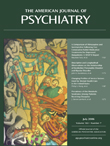This book is a collection of essays inspired by the third annual W.H.R. Rivers Workshop held at Harvard University in May 2002. Rivers was an English psychiatrist and anthropologist noted for his application of psychoanalytic methods to victims of shell shock during World War I. His most famous patient was the poet Siegfried Sassoon. Despite his success in healing young men who served in combat, Rivers had qualms about their return to active duty in the trenches of the Western Front. It is fitting that this collection of essays, which also bridges psychiatry and anthropology, should evoke qualms about our profession’s current activities.
The book is written primarily from an anthropological perspective, one that views every human attempt to know the world as another culturally bound set of beliefs. It is interesting to see what happens when this approach is brought to bear on the familiar terrain of psychiatric beliefs. Instead of traveling to distant shores to live among exotic tribes, the anthropologists study the world in which we practice—where psychiatrists, psychopharmacologists, and pharmaceutical corporation executives are the informants. In this world, the DSM-IV is held up as providing universally valid criteria by which brain diseases, “chemical imbalances,” can be accurately diagnosed and then by following “best practices” treated with the powerful medications that have been developed by the science of psychopharmacology and the pharmaceutical industry.
When successfully applied, the anthropological approach, as presented in the book, has the capacity to dissolve our everyday reality into a puddle of assumed beliefs. The pharmaceutical industry, psychopharmacologists, and psychiatrists become purveyors of an ideology that assumes that all human woes are mental illnesses amenable to treatment by chemicals. Ipso facto, these mental illnesses must be chemical imbalances. Since such physiochemical phenomena have universal validity, it is incumbent on all societies to institute the (same) policies of public and professional education: to identify all those suffering from these conditions and provide them with the (same) effective medications. Those who would oppose these views are unscientific or have succumbed to the influence of stigma.
From this perspective, as illustrated in the book, what psychiatrists might see as medical progress the anthropologists view as the medicalization and globalization of the world. The anthropologists also make clear that we psychiatrists play second fiddle in a system that is orchestrated by the pharmaceutical industry to expand their reach and profits. In this scenario, psychiatrists are used, not just to dispense particular medications, but more importantly to help create and then sell illnesses. Such explanations turn our world on its head. These explanations might suggest that instead of medications being developed to treat illnesses, illnesses are invented to sell medications. David Healy provides a revealing account of Upjohn’s launch of panic attacks to sell their me-too benzodiazepine Xanax. A similar theme is echoed by Kalman Applebaum in showing how the pharmaceutical industry used psychiatrists (and others) to sell depression to the Japanese, thereby expanding the market for selective serotonin reuptake inhibitors.
When it does work, this anthropological approach offers an “Aha!” experience, making us aware of what we knew but could not articulate. However, at its worst it reads like social science gobbledy gook written by wrong-headed academics whose insistence that all the phenomena we take for real (mental illness, the effectiveness of our medications, etc.) are actually social constructs, rings false. It is when the anthropological approach fails that one is reminded that absolute relativism is a double-edged sword, and that current anthropology is itself a culturally bound set of beliefs.

